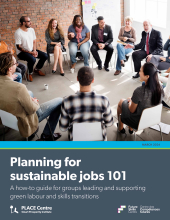A diverse group of adults sitting on chairs in a circle talking and smiling. They are participating in a business team seminar. A red brick wall is the backdrop with a whiteboard with sticky notes in the corner. (Photo credit: Rawpixel)
There is growing recognition across stakeholder groups that a skilled workforce is essential to designing, building, and advancing solutions to meet Canada’s climate targets and pursue net-zero emissions by 2050. Regions and sectors across the country are looking to help workers find meaningful employment in a clean economy, often by providing support for skills development and assisting workers’ transitions to new economic opportunities. However, there is little guidance on how groups leading the skills transition in Canada should go about it.
In light of these challenges, the Smart Prosperity Institute, in partnership with the Future Skills Centre, has worked to study and understand the core challenges in the labour and skills transitions for clean economy opportunities. Over the last 18 months, we have studied three specific opportunities, zero-emission vehicles in Ontario, plant-based protein in Manitoba and Saskatchewan, and mass timber in British Columbia. Our project examined what kinds of future skills and jobs will be needed, how the nature of the work is changing, what kinds of support and policies can aid businesses and workers alike, and how policymakers, educational institutions, and industry can both enable and smooth this transition.
Based on our findings in this report series, we have created Planning for sustainable jobs 101: A how-to guide for groups leading and supporting green labour and skills transitions. This report is a synthesis of our findings, insights, and research combined with international case studies to give practical advice and clear steps on how organizations – ranging from government departments to economic development agencies to industry associations – can begin to undertake the critical and necessary steps of planning and preparing for the workforce shifts that will accompany the green labour and skills transition.



